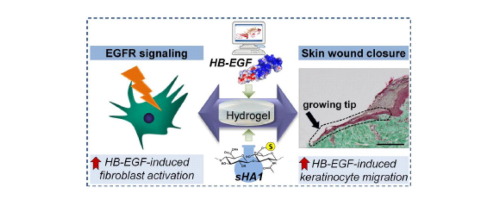Acta Biomaterialia ( IF 9.4 ) Pub Date : 2019-01-17 , DOI: 10.1016/j.actbio.2019.01.029
Stephan Thönes , Sandra Rother , Tom Wippold , Joanna Blaszkiewicz , Kanagasabai Balamurugan , Stephanie Moeller , Gloria Ruiz-Gómez , Matthias Schnabelrauch , Dieter Scharnweber , Anja Saalbach , Joerg Rademann , M. Teresa Pisabarro , Vera Hintze , Ulf Anderegg

|
Functional biomaterials that are able to bind, stabilize and release bioactive proteins in a defined manner are required for the controlled delivery of such to the desired place of action, stimulating wound healing in health-compromised patients. Glycosaminoglycans (GAG) represent a very promising group of components since they may be functionally engineered and are well tolerated by the recipient tissues due to their relative immunological inertness.
Ligands of the Epidermal Growth Factor (EGF) receptor (EGFR) activate keratinocytes and dermal fibroblasts and, thus, contribute to skin wound healing. Heparin-binding EGF-like growth factor (HB-EGF) bound to GAG in biomaterials (e.g. hydrogels) might serve as a reservoir that induces prolonged activation of the EGF receptor and to recover disturbed wound healing.
Based on previous findings, the capacity of hyaluronan (HA) and its sulfated derivatives (sHA) to bind and release HB-EGF from HA/collagen-based hydrogels was investigated. Docking and molecular dynamics analysis of a molecular model of HB-EGF led to the identification of residues in the heparin-binding domain of the protein being essential for the recognition of GAG derivatives. Furthermore, molecular modeling and surface plasmon resonance (SPR) analyses demonstrated that sulfation of HA increases binding strength to HB-EGF thus providing a rationale for the development of sHA1-containing hydrogels. In line with computational observations and in agreement with SPR results, gels containing sHA displayed a retarded HB-EGF release in vitro compared to pure HA/collagen gels. Hydrogels containing HA and collagen or a mixture with sHA were shown to bind and release bioactive HB-EGF over at least 72 h, which induced keratinocyte migration, EGFR-signaling and HGF expression in dermal fibroblasts. Importantly, hydrogels containing sHA strongly increased the effectivity of HB-EGF in inducing epithelial tip growth in epithelial wounds shown in a porcine skin organ culture model. These findings suggest that hydrogels containing HA and sHA can be engineered for smart and effective wound dressings.
Statement of Significance
Immobilization and sustained release of recombinant proteins from functional biomaterials might overcome the limited success of direct application of non-protected solute growth factors during the treatment of impaired wound healing.
We developed HA/collagen-based hydrogels supplemented with acrylated sulfated HA for binding and release of HB-EGF. We analyzed the molecular basis of HB-EGF interaction with HA and its chemical derivatives by in silico modeling and surface plasmon resonance. These hydrogels bind HB-EGF reversibly. Using different in vitro assays and organ culture we demonstrate that the introduction of sulfated HA into the hydrogels significantly increases the effectivity of HB-EGF action on target cells. Therefore, sulfated HA-containing hydrogels are promising functional biomaterials for the development of mediator releasing wound dressings.
中文翻译:

含有硫酸化透明质酸的透明质酸/胶原蛋白水凝胶可通过持续释放肝素结合性EGF样生长因子来改善伤口愈合
能够以限定的方式结合,稳定和释放生物活性蛋白质的功能性生物材料是受控地将其递送至所需作用部位,刺激健康受损患者的伤口愈合所必需的。糖胺聚糖(GAG)代表了非常有希望的一组组分,因为它们的相对免疫惰性可能是功能性工程改造的,并且被受体组织很好地耐受。
表皮生长因子(EGF)受体(EGFR)的配体激活角质形成细胞和皮肤成纤维细胞,因此有助于皮肤伤口的愈合。与生物材料(例如水凝胶)中的GAG结合的肝素结合型EGF样生长因子(HB-EGF)可能充当诱导EGF受体延长活化并恢复受损伤口愈合的储库。
基于先前的发现,研究了透明质酸(HA)及其硫酸化衍生物(sHA)从基于HA /胶原蛋白的水凝胶中结合和释放HB-EGF的能力。HB-EGF分子模型的对接和分子动力学分析导致鉴定蛋白质的肝素结合域中的残基对于识别GAG衍生物至关重要。此外,分子建模和表面等离振子共振(SPR)分析表明HA的硫酸化提高了与HB-EGF的结合强度,从而为开发含sHA1的水凝胶提供了理论依据。与计算观察结果一致,与SPR结果一致,与纯HA /胶原蛋白凝胶相比,含sHA的凝胶在体外的HB-EGF释放延迟。显示含有HA和胶原蛋白的水凝胶或与sHA的混合物在至少72小时内结合并释放生物活性HB-EGF,这会诱导真皮成纤维细胞中角质形成细胞迁移,EGFR信号传导和HGF表达。重要的是,含有sHA的水凝胶强烈增强了HB-EGF诱导猪皮肤器官培养模型中显示的上皮伤口中上皮尖端生长的有效性。这些发现表明,含有HA和sHA的水凝胶可经工程改造,以制成智能而有效的伤口敷料。
重要声明
从功能性生物材料固定化和持续释放重组蛋白可能会克服在伤口愈合不良的治疗过程中直接应用非保护性溶质生长因子所获得的有限成功。
我们开发了基于HA /胶原的水凝胶,并补充了丙烯酸酯化的HA,以结合和释放HB-EGF。我们通过计算机模拟和表面等离子体共振分析了HB-EGF与HA及其化学衍生物相互作用的分子基础。这些水凝胶可逆地结合HB-EGF。使用不同的体外测定和器官培养,我们证明了将硫酸化的HA引入水凝胶可显着提高HB-EGF作用于靶细胞的有效性。因此,硫酸化的含HA的水凝胶是用于开发释放介质的伤口敷料的有前途的功能性生物材料。




































 京公网安备 11010802027423号
京公网安备 11010802027423号